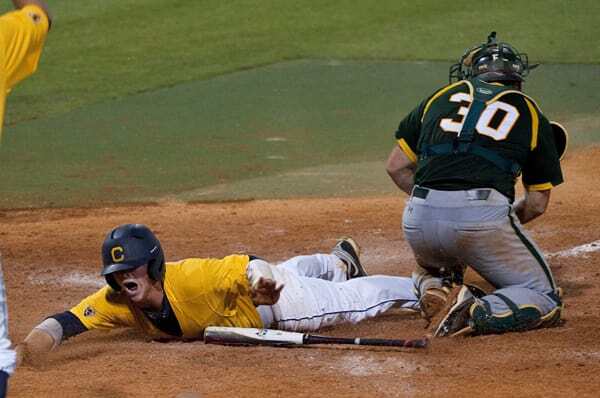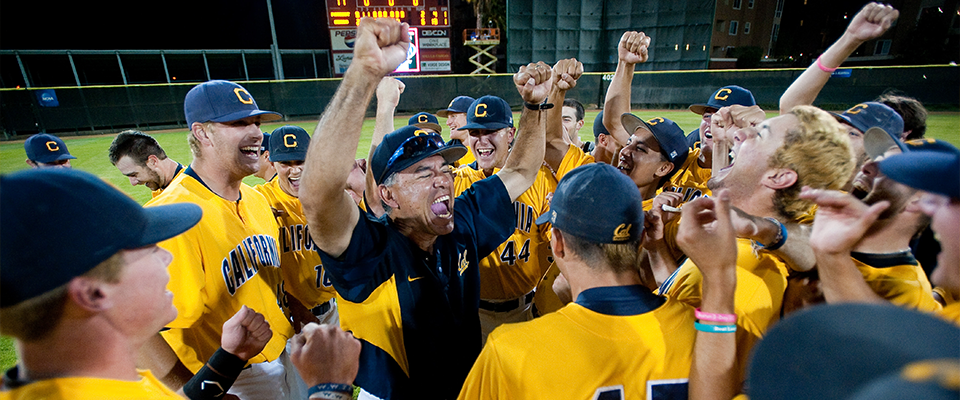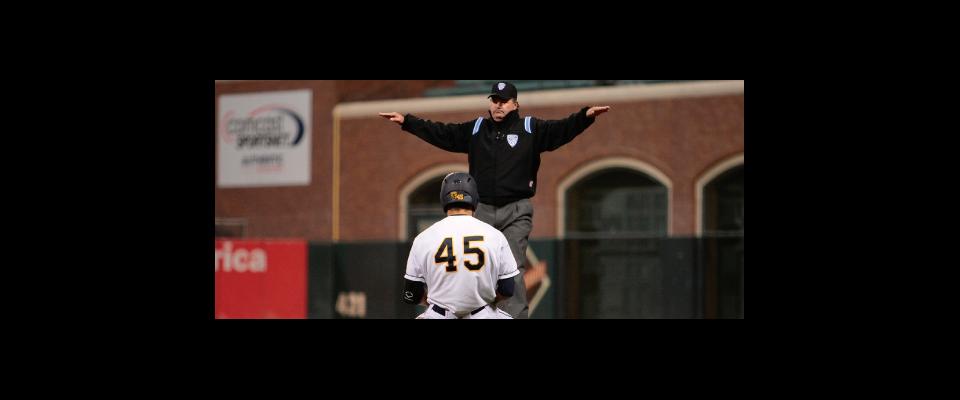Under darkened skies laden with humidity and sparked by lightning, Cal’s Devon Rodriquez slowly strode to the plate. It was June 6, 2011, the title game of the NCAA Baseball Regionals in Houston, the Golden Bears’ most crucial at-bat in their most dramatic of seasons—one in which the very existence of the team hung in the balance.
Cal, which had trailed the Baylor Bears, 7-1, going into the sixth inning, was able to get within 8-7 by the bottom of the ninth, thanks in part to Rodriquez’s two-run homer the inning before. But Baylor ace Logan Verrett had just struck out shortstop Marcus Semien with the bases loaded to put Cal one out away from season’s end.
Baseball had been a part of the university since 1892. But inconceivable or not, the team was put on the chopping block.
Rodriquez immediately fell behind in the count when he fouled off the first two pitches. Suddenly the Golden Bears were just one strike away from elimination, forming a collective pit in the stomachs of coach David Esquer’s squad, the Cal faithful in Houston, and the fans listening back home on campus radio station KALX.
“So much emotion came into that at-bat in Houston,” recalled Rodriguez. “It wasn’t just for me; it was for all my teammates, the program and the people who supported us. I felt like I had the whole year on my back.”
What a burdensome year it had been. Nearly nine months earlier, on September 28, 2010, Coach David Esquer’s team had been called into the Haas Pavilion Club Room by Chancellor Robert Birgeneau and Athletic Director Sandy Barbour to be told, along with men’s and women’s gymnastics and women’s lacrosse, that their sports would not exist at the University of California after the 2010-11 campaign. Additionally, the Bears’ nationally dominant men’s rugby team would be downgraded from varsity to club sport status.
The campus was in dire financial straits at that time, exacerbated by Memorial Stadium retrofit costs that had soared to more than half a billion dollars and by a 20 percent cut in California state funding for college education. The Cal athletic department was running annual deficits, while at the same time the campus was suffering lay-offs and dropping academic programs.
Still, to many observers, it was inconceivable the Bears would drop baseball. The sport had been a part of the university since 1892. Cal won the first College World Series in 1947 and won it again a decade later. The Bears had a history of developing Major Leaguers, and at one point during the 2010 season, Cal had more former players on MLB rosters than any other team in the nation.
Athletes are not, by nature, quitters, and college administrators have found cutting teams easier said than done.
Inconceivable or not, the team was put on the chopping block.
This may sound familiar. Last year, college athletic programs across the country, faced with empty stadiums and decreased revenues due to COVID-19, felt forced to downsize. In 2020-21, 70 Division I schools either dropped, cut, or suspended teams—including Cal’s rival Stanford, which announced the elimination of a whopping 11 varsity sports, including its successful men’s rowing, men’s volleyball, and wrestling squads.
Across the board, Olympic sports were hit especially hard, leaving many observers wringing their hands over the future of Team USA and wondering whether the model of intercollegiate athletics isn’t irrevocably broken.
If nothing else, cutting sports causes deep rifts within a campus community, in which students and alumni often feel betrayed by the very schools that once recruited them and reaped benefits from their successes.
But athletes are not, by nature, quitters, and college administrators have found cutting teams easier said than done.
WHEN THE NEW YORK TIMES got wind of what was happening in Berkeley, in February 2011, it noted in an article that the elimination of women’s lacrosse and women’s gymnastics would put Cal’s Title IX requirements out of whack. To be in compliance, the athletic department would have to add 50 women’s roster positions and cut 80 men’s roster spots.
Just three days later, Chancellor Birgeneau announced men’s rugby, women’s gymnastics, and women’s lacrosse would be reinstated to varsity status—not, however, baseball and men’s gymnastics.
For any Cal fans listening that night, it was a miracle—shades of Joe Starkey and his inimitable call of The Play, the impossible ending of the 1982 Cal-Stanford football game.
“Regrettably, in spite of the best efforts of a number of their key supporters, men’s baseball and men’s gymnastics fell far short of raising the necessary philanthropic support,” Birgeneau stated in a press release, reiterating that those teams would “cease competition as intercollegiate varsity sports” at the end of the academic year.
The Cal baseball community was furious. It was the second time they were being informed of their impending demise. Furthermore, they did not believe they had fallen short in their fundraising efforts.
Rather than give up, donors redoubled their efforts, raising nine million dollars in pledged donations in only two months. In April, the university finally relented, reinstating both baseball and gymnastics. All five teams were saved.
Meanwhile, on the diamond, Cal Baseball had battled valiantly amid the uncertainty, racking up a 31-20 record and qualifying for postseason play and a No. 3 seed in the Regionals. On that sultry June night in Houston, however, with Rodriguez down in the count, it now looked to be all over.
Student announcer Danny Freisinger called the game for KALX. “Bears trailing by one. Game 7, win or go home. Verrett comes set, looks at third. The pitch … a base hit into right field! Coming into score is Booker. Renda slips …. “
With the crack of Rodriquez’s bat, bedlam ensued as Austin Booker easily scored the tying run. But Tony Renda had to dig deep to complete the epic comeback. As he was about to round third base, Renda felt a pop in his right quad and stumbled, short of home plate. He got up lame but mustered enough strength to slide head-first into home.

“He’s safe!” a near-hysterical Freisenger bellowed over the airwaves. “And California wins 9-8!”
The team mobbed the field in a jubilant dog pile as a hoarse Freisinger practically hyperventilated at the mic.
I cannot believe that! I apologize, folks. I’m sure you didn’t hear any of that. Devon Rodriguez! … and California advances! Unbelievable. They score four times in the ninth inning, trailing 8-5! What a season for California!”
For any Cal fans listening that night, it was a miracle—shades of Joe Starkey and his inimitable call of The Play, the impossible ending of the 1982 Cal-Stanford football game. And, as with The Play, it was a reminder of why so many of us continue to watch sports—for proof that if we don’t give up, if we never say die, if we believe, we can prevail.
It’s cliché, sure. But every so often, the sports fan knows, the cliché comes to life.
After the Bears won in Houston they went on to win the Super Regionals as well, becoming media darlings along the way, hailed as a Cinderella squad that had beaten the odds both on and off the diamond. For his part, David Esquer was named National Coach of the Year. Alas, the team would fall short in the College World Series, losing two games to top-seeded Virginia, with a win over Texas A&M sandwiched in between. But the season was still heroic.
Where are they now? Ten years later, Marcus Semien is a starting infielder for the Toronto Blue Jays after many years with the Oakland A’s. Tony Renda collected a World Series ring with the 2018 Boston Red Sox. Devon Rodriguez, the hero of the win over Baylor, would be temporarily sidelined by injuries at Cal, including a life-threatening blood clot, but would nevertheless go on to have a successful career in the Independent Leagues, last with the Saint Paul Saints.
As for David Esquer, he now coaches at this alma mater, Stanford. The Cardinal, by the way, brought back all eleven of the teams it cut earlier in the year after a long, concerted effort by alumni, including two lawsuits filed against the school.
No doubt they were inspired by their rivals up the road to keep fighting.
Scott Ball was the Sports Information Director for Cal baseball for 25 years, and is the only Golden Bear SID to cover two College World Series teams (1992 and 2011) for the university. He currently resides in Madison, WI with his wife and daughter.




















